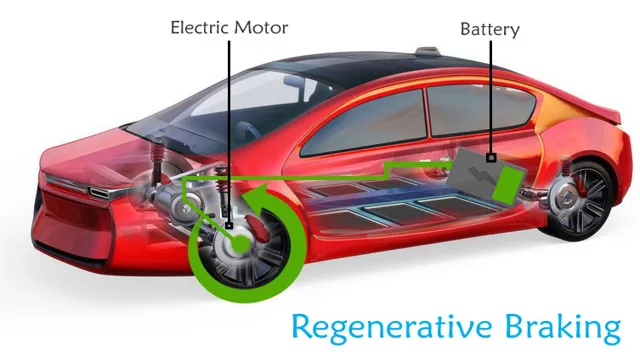Electric cars are becoming increasingly popular as they offer a cleaner, more efficient way of traveling. But what exactly is regenerative braking in an electric car? Regenerative braking is a system that allows electric vehicles to recover and reuse some of the energy that is normally lost during braking. This energy is then stored in the vehicle’s battery, allowing it to be used again later.
In this blog, we will explore how regenerative braking works and the potential benefits it can provide to electric car owners.
Overview
Regenerative braking in an electric car is a method of recovering energy otherwise wasted in traditional braking systems. Instead of the energy being converted to heat and lost, regenerative braking systems capture the energy created when the car brakes and store it to be used later. This type of braking is becoming increasingly popular in electric and hybrid cars.
It has a number of advantages over traditional braking. Firstly, it reduces the need to stop and recharge, as the car can store the energy it creates when braking. Secondly, it improves the overall efficiency of the car, as the energy is not wasted and can be reused.
Regenerative braking systems work by capturing the energy created when the car brakes and storing it in an onboard battery. This energy can then be used to power the car’s electric motor, which helps to reduce the amount of fuel used. Some systems can even be programmed to capture the energy more efficiently, making them more efficient than traditional braking systems.
The regenerative braking system works by using the electric motor as a generator when the car brakes. The motor converts the kinetic energy created when the car brakes into electrical energy, which is then stored in the battery. This energy can then be used to power the car’s electric motor when the car accelerates.
In addition to improved efficiency, regenerative braking systems also provide a smoother ride and reduce noise pollution. This is because the energy generated is returned to the battery, rather than being converted to heat and lost. In summary, regenerative braking in an electric car is a method of recouping energy wasted in traditional braking systems.
It improves the efficiency of the car, provides a smoother ride and reduces noise pollution. With its numerous advantages, this type of braking is becoming increasingly popular in electric and hybrid cars.
Definition of Regenerative Braking
Regenerative braking is a technology found in electric and hybrid cars that captures the energy otherwise lost during braking and uses it to recharge the car’s battery. As the driver decelerates, the car’s electric motor acts as a generator, converting the car’s kinetic energy into electricity. This electricity is then stored in the car’s battery for later use.
Regenerative braking is a great way to increase the efficiency of electric and hybrid cars, as it helps to reduce the amount of energy needed to power the car.

How Does Regenerative Braking Work?
Regenerative braking is a technology used in electric vehicles to convert kinetic energy into electricity, which is used to recharge the battery. In a nutshell, when the driver applies the brakes, the electric motor in the vehicle acts as a generator and captures the energy from the slowing of the wheels. This energy is then converted into electricity and stored in the vehicle’s battery, allowing for the battery to be recharged without the need for an external power source.
This technology provides numerous benefits, as it reduces the amount of energy required to keep the vehicle running and can also extend the range of the vehicle by providing a supplemental energy source.
Benefits of Regenerative Braking
Regenerative braking is an energy recovery system that captures the kinetic energy of a car and reuses it to save energy. This system is becoming increasingly popular in electric cars and hybrids, and can significantly improve their efficiency. In a typical car, the kinetic energy created when the car brakes is dissipated as heat.
This heat is then lost as the car slows down. However, with regenerative braking, the kinetic energy is recovered and stored instead of being dissipated. This energy is then used to help power the car when it accelerates.
For example, when a car is slowing down, regenerative braking works by using an electric motor to convert the car’s kinetic energy into electricity and store it in a battery. When the driver accelerates, the battery is used to help power the car. This helps to conserve the car’s energy, resulting in improved fuel economy.
The benefits of regenerative braking don’t stop at fuel economy. Some cars also use regenerative braking to increase their range. In electric cars, the regenerative braking can be used to help recharge the battery.
This can extend the range of the car, enabling drivers to travel further on a single charge. Regenerative braking also helps to improve the overall performance of the car. The electric motor used in regenerative braking can provide additional power when the car accelerates.
This can result in a smoother and more responsive driving experience. Finally, regenerative braking helps to reduce the environmental impact of cars. By helping to reduce the amount of fuel consumed by the car, regenerative braking helps to reduce carbon emissions and other pollutants.
Increased Efficiency
Regenerative braking is a key component of electric cars that provides an efficient way to conserve energy and extend the range of the vehicle. It works by using the electric motor in the car to apply resistance to the wheels when the brakes are applied, and in doing so, it captures the energy from the car’s motion and turns it into electric energy, which is then stored in the car’s batteries.
This captured energy can then be used to power the electric motor when the car accelerates, making it an efficient and cost-effective way to maximize the performance of an electric car.
Reduction in Wear and Tear
Regenerative braking in electric cars is a revolutionary system that reduces wear and tear on the vehicle while also helping to improve fuel efficiency. The system works by using the electric motor of the car to slow the vehicle down, rather than relying on the traditional brakes. This helps to recapture some of the energy that is lost when the car brakes, allowing it to be reused to help power the vehicle.
This not only reduces the amount of energy needed to keep the car running, but it also reduces the amount of wear and tear on the brakes, leading to improved performance and a longer lifespan.

Increased Range
Regenerative braking is an innovative technology found in electric cars that helps to increase their range. It works by harvesting the kinetic energy generated when the car is slowing down and converting it into electricity that is stored in the car’s battery and can be used to power the car. This helps to reduce the amount of energy used from the battery, allowing the car to travel farther on a single charge.
Regenerative braking is just one of the many features of electric cars that make them an increasingly attractive option for drivers looking to reduce their environmental impact and enjoy the benefits of a zero-emissions vehicle.
Conclusion
Regenerative braking in electric cars is a smart and efficient way to convert the car’s kinetic energy into electricity, saving energy and helping to reduce emissions. This process of using the car’s momentum to charge the battery is key to achieving a cleaner and more sustainable future. So, if you’re looking for a way to save energy and help the environment, regenerative braking is the way to go.
Frequently Asked Questions [FAQs]
1. What is regenerative braking in an electric car?
Regenerative braking in an electric car is a mechanism that uses the electric motor to slow the vehicle down. Instead of relying solely on the friction brakes, the electric motor is used to convert the car’s kinetic energy into electrical energy, which is then stored in the car’s battery.
2. How does regenerative braking in an electric car work?
Regenerative braking in an electric car works by using the car’s electric motor as a generator. The electric motor is used to convert the car’s kinetic energy into electrical energy, which is then stored in the car’s battery. As the electric motor turns, it produces a magnetic field that interacts with the car’s electrical system to create a current. This current is then used to slow the car down.
3. What are the benefits of regenerative braking in an electric car?
The main benefit of regenerative braking in an electric car is that it helps to conserve energy. By capturing the car’s kinetic energy and storing it in the battery, it can be used later on for propulsion. This helps to reduce fuel consumption and emissions, making it more environmentally friendly.
4. Is regenerative braking in an electric car more efficient than traditional brakes?
Yes, regenerative braking in an electric car is more efficient than traditional brakes. By capturing the car’s kinetic energy and storing it in the battery, it can be used later on for propulsion. This helps to reduce fuel consumption and emissions, making it more efficient than traditional brakes.
5. Is regenerative braking in an electric car safe?
Yes, regenerative braking in an electric car is safe. The system is designed to work in tandem with the traditional brakes to provide a smooth and controlled braking experience. The brakes are still in charge of providing the majority of the stopping power, so the regenerative braking system is just an added layer of safety.
6. How often should the regenerative braking system in an electric car be serviced?
The regenerative braking system in an electric car should be serviced at least once a year. This is to ensure that it is functioning properly and to ensure that the battery is being charged correctly. Regular maintenance and servicing of the regenerative braking system will help to ensure it is working efficiently and reliably.

I am James Beaupre, the founder of batteryvehicleprice.com. With a deep-rooted passion for vehicle batteries, I have dedicated my career to exploring and understanding the intricacies of this crucial technology. My website aims to provide valuable insights and information on battery-powered vehicles, empowering individuals to make informed decisions.
